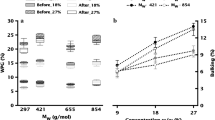Summary
Embedding of small wood blocks for study of changes in pit structure during treatments of wood, such as various drying methods, may cause considerable damage to the pit membranes. The sapwood of three species was studied: Sitka spruce, Douglas-fir, and Pacific silver fir. Drying was done by air-drying, freeze-drying, and solvent-seasoning. The principal embedding medium used was butyl-methyl methacrylate. Other media used were celloidin, paraffin, and commercial epoxy and polyester resins.
Damage to tracheid bordered pit membranes was found with all media and most woods and drying conditions, although there was much variation. In wood embedded in methacrylate monomers, the damage ranged from nearly aspirated pits, even in unseasoned wood which was solvent exchanged and diffusion embedded, to tori protruding from the aperture and to tori completely dislodged and removed from the pit cavity.
The greatest pit damage occurred with nerver-dried wood, which was solvent exchanged and diffusion embedded. Air-dried spruce embedded in celloidin and commerically dried spruce embedded either in epoxy or methacrylate showed no appreciable displacement of tori. Freeze-drying of wood reduced but did not eliminate pit aspiration although the results are somewhat confounded with the effects of embedding. Embedded freeze-dried wood also showed pit damage. In solvent-exchanged embedded wood less aspiration occurred.
Rupture of the pit membrane and torus displacement is probably caused by the stresses and plastic flow in the shrinking embedding medium during polymerization of resin systems or cooling of non-resin systems. Care must be taken in observing results of wood treatments that the observations are not brought about by the embedding method itself.
Zusammenfassung
Die Einbettung kleiner Holzproben zur Untersuchung der Tüpfelstrukturänderungen bei der Behandlung von Holz, z. B. durch verschiedene Trocknungsverfahren, kann zu erheblichen Beschädigungen der Tüpfelmembranen führen. Untersucht wurde das Splintholz dreier Holzarten: Sitka-Fichte, Douglasie und die Pazifik-Silbertanne. Die Trocknung erfolgte durch Luft-, Gefrier- und Lösungsmitteltrocknung. Als Einbettungsmittel wurde hauptsächlich Butyl-Methyl-Methacrylat verwendet, daneben Zelloidin, Paraffin sowie handelsübliche Expoxyd- und Polyester-Harze.
Bei allen Einbettungsmitteln, den meisten Holzarten und Trocknungsverfahren wurden Beschädigungen der Tracheiden-Hoftüpfelmembranen festgestellt, allerdings in vielerlei Variationen. Bei in Methacrylatmonomeren eingebettetem Holz reichten die Beschädigungen vom fast geschlossenen Tüpfel, auch in ungetrocknetem lösungsmittel- und diffusionsbehandeltem Holz, bis zu aus der Öffnung herausragenden oder vollständig losgelösten und aus dem Tüpfelhof entfernten Tori.
Die größten Schäden entstanden bei Tüpfeln in ungetrocknetem Holz nach Lösungsmittelaustausch und Einbettung. Luftgetrocknetes, in Zelloidin eingebettetes und normal getrocknetes, in Epoxyd- oder Methylacrylat eingebettetes Fichtenholz zeigte keine wesentlichen Tori-Verlagerungen. Gefriertrocknen von Hölzern bewirkte eine Verminderung jedoch nicht vollständige Ausschaltung des Tüpfelhofverschlusses; diese Ergebnisse sind jedoch von den Wirkungen der Einbettung überlagert. Eingebettetes, gefriergetrocknetes Holz wies ebenfalls Tüpfelbeschädigungen auf. Bei Lösungsmittelaustausch und Einbettung des Holzes kam es weniger oft zu Tüpfelhofverschlüssen.
Der Bruch der Tüpfelmembranen und die Verlagerung der Tori wird wahrscheinling durch Spannungen und plastisches Fließen in den schrumpfenden Einbettungsmitteln während der Polymerisation der harze oder während der Abkühlung der anderen Einbettungsmedien verursacht. Bei der Untersuchung der Wirkung bestimmter Arten der Holzbehandlung muß daher sorgfältig darauf geachtet werden, daß diese Wirkungen nicht mit jenen der Einbettmethode verwechselt werden.
Similar content being viewed by others
References
Erickson, H. D., and R. J. Crawford: The effects of several seasoning methods on the permeability of wood to liquids. Amer. Wood Pres. Assoc. Proc. 55 (1959) 210–220.
Erickson, H. D., R. N. Schidt and J. R. Laing: Freeze-drying and wood shrinkage. For. Prod. J. 18 (1968) No. 6, 63–68.
Liese, W., and J. Bauch: On the closure of bordered pits in conifers. Wood Sci. Technol. 1 (1967) No. 7, 1–13.
Nicholas, D. D., and R. J. Thomas: Influence of steaming on ultrastructure of bordered pit membrane in loblolly pine. For. Prod. J. 18 (1968) No. 1, 57–59.
Panshin, H. J., D. deZeeuw and H. P. Brown: Textbook of wood technology. Vol. I, 2nd Ed. New York, N. Y. 1964: McGraw-Hill Book Co.
Pease, D. C.: Histological techniques for electron microscopy. Second edition. (pp. 100–105). New York, N. Y. 1964: Academic Press.
Riddle, E. H.: Monomeric acrylic esters. New York, N. Y. 1954: Reinhold Pub. Corp.
Thomas, R. J.: The structure of the pit membranes in longleaf pine: an electron microscope study. Amer. Wood Press. Assoc. Proc. 63 (1967) 20–29.
Author information
Authors and Affiliations
Additional information
The research was financed by the Institute of Forest Products and College of Forest Resources, University of Washington, Seattle.
Rights and permissions
About this article
Cite this article
Erickson, H.D., Schmidt, R.N. Rupture of pit membranes during embedding procedures. Wood Science and Technology 3, 194–202 (1969). https://doi.org/10.1007/BF00367211
Received:
Issue Date:
DOI: https://doi.org/10.1007/BF00367211




